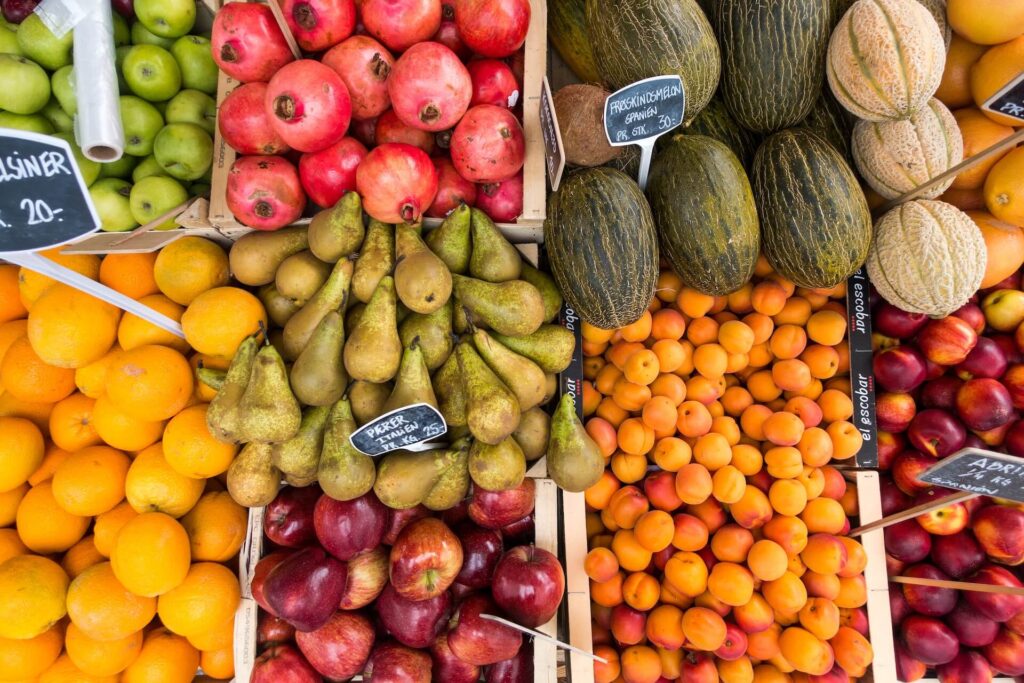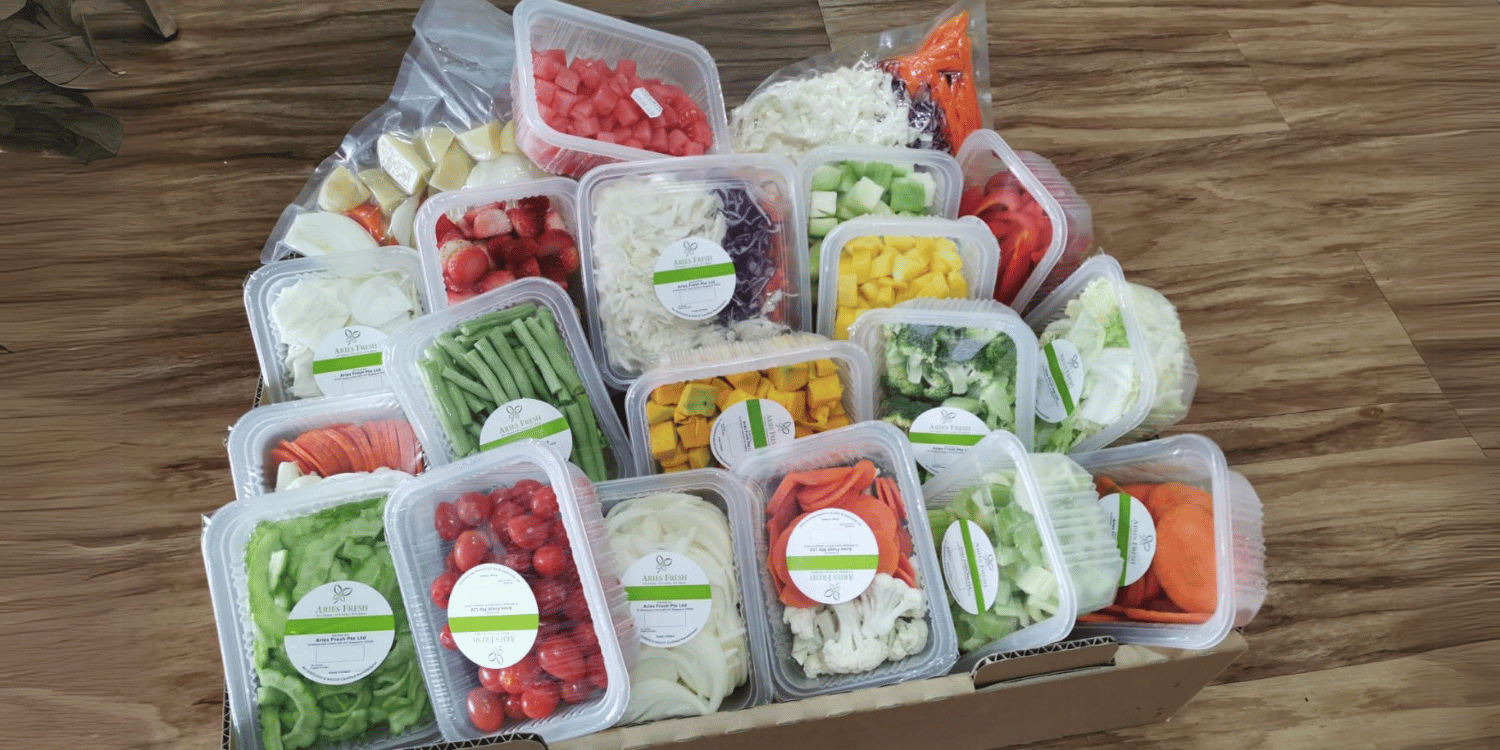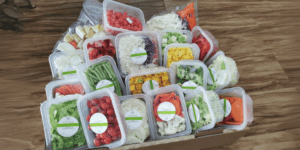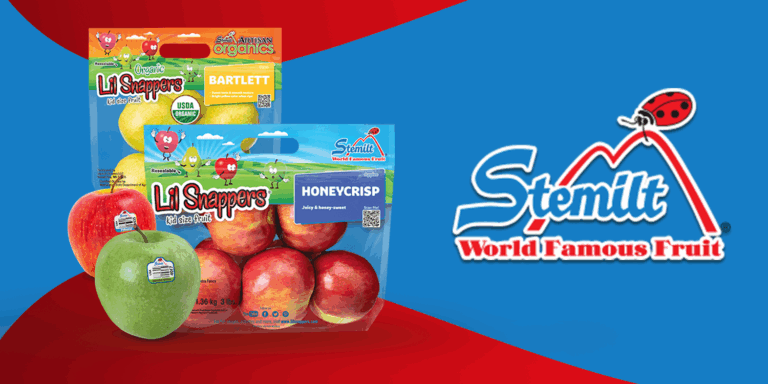Understanding the importance of sustainability in today’s retail environment is no longer optional.
It’s a strategic imperative for businesses aiming to thrive in the long run.
Especially in the produce retail sector, sustainable practices are key to ensuring a healthier future, both for the planet and the business itself.
Adapting the retail space to be more sustainable is a multi-faceted task.
It involves smart planning, careful implementation, and being abreast with emerging trends.
This post will breakdown the most effective strategies that can help produce retailers transition towards a more sustainable business model.
Contents [hide]
- Steps To Create A More Sustainable Produce Retail Space
- 1. Reduce Plastic for Packaging, Opt for Compostable Materials
- 2. Install Energy-Efficient Lighting and Cooling Systems
- 3. Source Locally Grown, Organic Produce
- 4. Employ Rainwater Collection for Irrigation Needs
- 5. Use Renewable Energy Sources for Power
- 6. Implement a Comprehensive Recycling Program
- 7. Reduce Food Waste Through Composting
- 8. Limit Use of Printed Promotional Materials
- 9. Use Eco-Friendly Cleaning Products and Supplies
- 10. Opt for Natural, Sustainable Decoration and Furniture
- 11. Encourage customers to bring reusable shopping bags
- 12. Install Temperature Controlling Windows and Doors.
- 13. Use Digital Displays for Aisles and Pricing
- 14. Educate Consumers About Sustainable Shopping Habits
- 15. Donate Unsold Produce to Local Food Banks
- 16. Promote Plant-Based Options More Prominently
- 17. Regularly Review Sustainability Goals and Performance
- Final Thoughts
Steps To Create A More Sustainable Produce Retail Space
1. Reduce Plastic for Packaging, Opt for Compostable Materials
As a significant initial step towards creating a more sustainable retail space, it is crucial to reduce plastic for packaging in favor of other more eco-friendly options.
Plastic is non-biodegradable, and its rampant use threatens our environment – specifically, our oceans and marine life.
One urge to complete this transformation is to transition to compostable materials for packing the produce.
These materials could include plant-based plastics, molded pulp, or corrugated cardboard, among others.
Such materials are not only environmentally friendly but they also present a positive perception about the brand to the environmentally conscious customer.
Eco-friendly packaging also has the advantage of being compostable or recyclable.
By embracing compostable materials, a retail space not only makes a positive impact on the environment but also enhances its brand image.
Take, for example, the innovative introduction of Mushroom® Packaging for some business giants.
These companies have successfully shown that it’s possible to replace traditional, environmentally harmful plastic packaging with modern, sustainable solutions.
The novelty of such options attract customers who appreciate the store’s conscious efforts towards sustainability.
This leads also to a broader conversation about the overall reduction in packaging materials.
Retailers can encourage customers to bring their own reusable shopping bags, or perhaps containers, while purchasing bulk items.
By encouraging a culture of reusage, retail spaces can significantly reduce the dependency on single-use plastic bags, reducing their environmental footprint.
Remember, the goal of these strategies is not only to create a more sustainable retail space but also to influence customers and other businesses to follow suit.
Besides, addressing global issues like waste management and sustainability adds great value to an organization’s corporate responsibility.
2. Install Energy-Efficient Lighting and Cooling Systems
When it comes to creating a more sustainable retail space, installing energy-efficient lighting and cooling systems is a crucial step.
The main benefit of these systems is that they contribute significantly to reducing the environmental footprint of a business.
One of the most useful types of energy-efficient lighting is LED lighting.
These lights last significantly longer, use less electricity, and provide excellent quality and range of lighting when compared to traditional retail lighting options.
A movement towards adopting LEDs in retail spaces can result in a significant reduction in energy usage and, consequently, carbon emissions.
Furthermore, installing lighting control systems such as motion sensors or timers are fundamental when driving the sustainability initiative as they ensure lights are only used when necessary.
Now shifting focus on cooling systems, energy-efficient models are essential in reducing energy consumption.
These models can either be air conditioners or coolers that have been designed to utilize less power while providing the same, if not better, levels of cooling.
One practical step is to replace old, less efficient cooling systems with those rated with a high Seasonal Energy Efficiency Ratio (SEER).
These devices operate at a reduced capacity for most of the time, which results in lowered energy usage and lower operational costs.
Besides the positive implications for the environment, these systems affect the bottom-line positively by reducing costs.
However, it’s imperative to note that the installation of these systems should be executed by skilled professionals who understand the unique requirements of your retail space.
Moreover, diligent maintenance of these systems is crucial to ensure they continue to operate optimally and efficiently over time.
Last but not least, consider investing in renewable energy sources such as solar or wind energy to power your lighting and cooling systems.
Incorporation of these systems becomes an excellent example of responsible energy use in business.
It’s therefore evident that the installation of energy-efficient systems plays a significant part in creating a more sustainable produce retail space.
3. Source Locally Grown, Organic Produce
Understanding the importance of sourcing locally grown, organic produce is a critical step in creating a more sustainable produce retail space.
Doing this significantly reduces carbon emissions associated with long-distance transportation of goods.
Local farmers use sustainable farming practices that are good for local ecosystems and will typically have fresher, higher quality produce to offer.
Moreover, it allows businesses to contribute to the local economy and support small-scale farmers.
When businesses source locally, they create a positive impact on their community and contribute to the overall sustainability of the retail space.
Organic farming practices also have multiple benefits.
They reduce the amount of toxins, fertilizers, and pesticides that seep into the earth and water systems.
These practices promote biodiversity and help maintain soil health, contributing to healthier produce for consumers.
Farm-to-table solutions, where the retailer collaborates with local producers, are an excellent way to ensure that the produce is fresh, organic, and local.
Informing customers about where their produce is coming from can also enhance their shopping experience.
Customers feel more connected to their food when they know it’s from their local community and has been grown sustainably and organically.
This might feel like a small step, but it brings a significant change in the way the retail space operates and its impact on the environment.
Remember that sourcing locally grown, organic produce does not only mean to improve the integrity of the products on the shelves but also to build and foster a relationship with the local farming community.
Consumer awareness and demand for local, organic products are at an all-time high, and retailers that can provide these products will have a competitive edge for their sustainable practices.
To help retailers transition to sourcing from local, organic producers, there are toolkits and guides available for business owners.
They provide detailed information on how to connect with local farmers, negotiate terms, and arrange for fresh deliveries of high-quality organic produce.
4. Employ Rainwater Collection for Irrigation Needs
The fourth step in creating a more sustainable produce retail space is to employ rainwater collection for irrigation needs.
Rainwater collection is not just an eco-friendly alternative to using fresh water for purposes like cleansing and irrigation, but also a cost-effective solution.
Collecting and using the rainwater falling on your retail space can reduce your demand for mains water and decrease your water bills.
Moreover, rainwater is free from many of the chemicals found in tap water, making it a better choice for a store that prioritizes organic and natural produce.
Rainwater collection systems are not overly complex or expensive to install.
They can range from a simple barrel under a downspout to more sophisticated systems with pumps, filters, and tanks.
In addition, rainwater collection promotes water self-sufficiency and reduces reliance on city water supplies, which are often strained during times of drought.
Utilizing a rainwater collection system can also help to combat water scarcity, a problem that is increasing with climate change.
As rainwater has a balanced pH and is free from hard water minerals, it’s less harsh on your plants, making it ideal for irrigating your produce.
Furthermore, customers who prioritize environmental responsibility will appreciate and potentially choose your store over others, given your effort to conserve water.
By installing a rainwater collection system for irrigation, not only are you saving on water bills and conserving a critical resource, but you are also adding a unique marketing point for your retail space.
It is also a tangible and visible step, showing your commitment to sustainability in your retail space.
By implementing a rainwater collection system, a store can significantly reduce its environmental footprint.
This step, along with others in a comprehensive sustainability plan, can help to create a more sustainable produce retail space.
Educating your customers about your rainwater collection can also enlighten them about water conservation and can potentially inspire them to do so at home, thus broadening the positive environmental impact.
5. Use Renewable Energy Sources for Power
As part of a focused initiative on creating a more sustainable produce retail space, the use of renewable energy sources for power becomes an essential consideration.
There are numerous types of renewable energy sources that a retail space can exploit to power its operations.
This transition away from fossil fuels towards renewables is pivotal in achieving a reduced carbon footprint.
By harnessing the power of the sun with solar panels, the wind with wind turbines, or the earth with geothermal energy, businesses not only reduce their dependence on non-renewable sources but also save considerably on their energy bills.
Installation of solar panels on the rooftops can provide power for specific uses such as lighting, and space heating or cooling.
Wind turbines, particularly in areas with substantial wind resources, can contribute significantly to the energy mix of the store.
Other renewable options include bioenergy from organic waste and geothermal energy, depending on the operational feasibility and location of the retail space.
Switching to renewable energy sources requires both an initial investment and a long-term commitment to sustainability.
However, the long-term benefits in terms of energy cost savings and the positive impact on the environment make it a worthy investment.
Using renewable energy for retail spaces may also boost the image of the store among environmentally-conscious customers, which can translate into increased sales and customer loyalty.
It’s also important to ensure that the shift towards renewable energy sources is done in a measured and thoughtful manner, ensuring that the energy needs of the store are adequately met without causing operational disruptions.
By partnering with expert renewable energy solution providers, retail store owners can implement an effective renewable energy strategy that complements and supports the other sustainability initiatives in the store.
There’s more about how renewable energy sources can power a business in the following video:
Thus, a well-executed switch to renewable energy sources for power in a retail space can provide the dual benefits of environmental conservation and operational cost savings in the long run.
Indeed, with the right strategy and implementation, the use of renewable energy sources for power will play a fundamental role in the creation of a sustainable produce retail space.
6. Implement a Comprehensive Recycling Program
In the journey towards creating a more sustainable produce retail space, one of the key steps is the implementation of a comprehensive recycling program.
This goes beyond the simple act of putting out a recycling bin in your store.
It involves having a detailed plan for how to collect, sort, and recycle all kinds of waste materials that your store generates.
One of the first steps in establishing this program is to conduct an audit of your waste, identifying the types of materials you have and the quantities in which they are produced.
Once you have this information, you can research the recycling options available in your local area for each type of waste.
For instance, many municipalities offer services for recycling of paper and cardboard, while others have facilities for recycling plastics, metals, and glass.
For organic waste like food scraps and yard debris, you could look into composting options, or find a local composter or organics recycling facility that would take your waste.
Putting bins or containers in your store for the collection of these different types of waste is an essential part of the program.
However, you also need to train your employees on how to properly sort waste materials and make sure they are familiar with the recycling guidelines in your area.
In addition, it’s important to communicate with your customers about your recycling efforts and encourage them to participate – for example, by bringing back plastic containers for reuse or recycling, or by composting their food scraps at home.
You could also think about partnering with other local businesses or organizations to set up a shared recycling program or establish a recycling co-op, which could help reduce the costs and increase the efficiency of your efforts.
Ultimately, the goal is to reuse, recycle, or compost as much of your waste as possible, while sending as little as possible to the landfill.
This not only is beneficial for the environment, but it can also help you reduce your waste disposal costs, and can be a selling point for environmentally conscious customers.
Remember, in implementing a comprehensive recycling program, the key is to start small and gradually expand your efforts as you become more familiar with the process and as recycling options in your area improve.
Even small steps, like recycling cardboard boxes or composting food scraps, can make a significant difference in reducing your environmental footprint.
7. Reduce Food Waste Through Composting
Many people are unaware of the significant amount of waste produced in the retail sector, particularly in produce retail.
Composting is an effective method for reducing this waste.
Not only does it prevent organic matter from ending up in landfills, it also enriches the soil in your garden.
Reducing food waste through composting can benefit the environment in numerous ways.
It can help reduce greenhouse gas emissions, as food waste that decomposes in landfills produces a large amount of methane, a potent greenhouse gas.
By composting, we’re diverting the waste from the landfill and, in the process, creating a useful product that improves soil health and promotes plant growth.
Another bonus of composting is that it can save retailers money since they can reduce waste disposal costs and potentially even sell the compost.
But reducing waste in produce retail through composting does not mean throwing all waste into a compost bin.
To compost effectively, you need to understand the basics of composting and teach your staff to separate compostable and non-compostable waste.
Common compostable items in produce retail include fruits and vegetables, coffee grounds, tea bags, and paper bags.
Taking the initiative to compost at your retail space not only benefits the environment and potentially your bottom line, but it also sets a positive example for customers.
Many consumers today are more conscious of sustainability and appreciate businesses that share this value.
By clearly signposting your composting efforts, you can inspire your customers to take similar steps in their own homes, thereby creating a ripple effect that further promotes sustainability.
Reducing food waste via composting is a crucial step towards creating a more sustainable produce retail space.
If you’ve not yet explored this, I strongly encourage you to do so.
This could be the start of your journey towards creating a sustainable produce retail space that’s not only good for the environment but also for your business and customers.
8. Limit Use of Printed Promotional Materials
In an era dominated by the digital, it seems increasingly unnecessary to rely on traditional printed promotional materials that contribute significantly to waste and ecological degradation.
The retail industry, in particular, has long been reliant on paper-based catalogues, flyers, banners, and posters for promotional events and sales.
However, these resources, while effective, produce a substantial amount of waste that adds to the global crisis of deforestation and landfill.
It’s crucial to remember that the production of such materials not only requires the cutting down of trees, but also utilizes energy and water, and generates carbon emissions and waste water.
On the other hand, the caveat is that digital-based promotions also contribute to emissions from energy usage.
Yet, when calculated per user, this tends to be significantly lesser than the impact of physical printed materials.
Undeniably, streamlining the promotional practices into digital can play a substantial role in reducing the environmental impact of a retail business.
The potential reach of digital advertising is also significantly greater, allowing businesses to reach more people with less environmental impact.
Integrating promotions with loyalty apps, email newsletters, social media channels, and the retailer’s website can prove equally, if not more, effective in reaching out to the target audience.
Also, it’s essential not just to limit the use of printed material but to aim for ethical and sustainable alternatives when it’s necessary to use them.
Options such as recycled paper, vegetable-based inks, or even seeded paper that can be planted to grow flowers or herbs are relevant and impactful choices.
Moreover, it’s crucial to educate consumers about these initiatives, reinforcing the importance of responsible consumption, and ensuring that we do not just transfer the problem from one area to another.
In pursuit of a more sustainable produce retail space, keeping promotional practices digitally-focused and following best practices when printed elements are unavoidable can significantly contribute to reducing the business’s ecological impact.
Promoting these efforts can also encourage customer loyalty, as a growing number of consumers prefer to associate with brands that consider the environmental implications of their operational activities.
Therefore, limiting the use of printed promotional materials can prove to be a strategic and sustainable measure in the retail industry.
9. Use Eco-Friendly Cleaning Products and Supplies
Creating a more sustainable produce retail space goes beyond just sourcing locally grown, organic produce.
It also involves adopting practices that reduce our carbon footprint in every aspect of the retail operation.
One significant step in this direction is the use of eco-friendly cleaning products and supplies.
In conventional retail spaces, cleaning operations often rely on chemical-laden products that harm the environment, contributing to both air and water pollution.
However, with a shift towards sustainability, retailers can opt for cleaning products that are biodegradable, non-toxic, and plant-based.
These green products not only serve the same purpose but do so without negatively impacting the planet.
Transitioning to eco-friendly cleaning supplies is an actionable way to reduce harmful wastes and contribute to a cleaner, more sustainable environment.
Many eco-friendly cleaning products are concentrated and come in recyclable packaging, leading to less waste overall.
Some companies even offer refillable containers, thus eliminating the need for more plastic waste.
The eco-friendly cleaning supplies’ production process also tends to be more sustainable than for conventional cleaning products, with companies prioritizing renewable resources.
It’s not only about the supplies; the use of energy-efficient cleaning equipment such as mops, vacuum cleaners, and floor scrubbers further enhances a retailer’s sustainability efforts.
Considering the large-scale use of cleaning products in retail spaces, this shift can have a significant positive impact on the environment.
Transitioning to eco-friendly cleaning supplies is, no doubt, a commendable step towards sustainability, but it’s equally important to learn the correct usage of these products.
They are often concentrated and require less quantity per use, so overuse should be avoided.
It’s also crucial to train the staff about these new products and their advantages, both for the environment and their personal health.
Over time, these small changes can add up and contribute to a larger, more significant impact on environmental conservation.
These efforts in switching to eco-friendly cleaning products and supplies not only represent a step towards environmental responsibility, but can also appeal to today’s educated consumer base who increasingly prefer businesses that value sustainability.
10. Opt for Natural, Sustainable Decoration and Furniture
When considering the interior design for a sustainable retail space, the choice of decoration and furniture plays a significant role.
With the rise in awareness about environmental conservation, many manufacturers are now designing and creating sustainable furniture made from responsibly sourced, recycled, or reclaimed materials.
Sustainable furniture not only reduces the need for new raw materials but also the amount of waste sent to landfills.
The decoration for a sustainable retail space should also prioritize natural, sustainable materials.
For example, decor made from bamboo, a highly renewable resource, or recycled plastic, gives a second life to materials that would otherwise end up in landfills.
Retailers can also utilize living plants as decoration, which not only add a pleasant, natural aesthetic to the store but also help improve indoor air quality.
The decoration could also feature creative use of reclaimed materials, such as old barn wood for wall paneling or bicycle parts for lighting fixtures, adding a unique and interesting touch while promoting sustainability.
Another significant aspect when picking decoration and furniture is considering the lifecycle of the product.
Opting for items that are durable and long-lasting, or that can be readily recycled or composted at the end of their useful life, is a crucial part of promoting a more sustainable retail environment.
This could, for example, include selecting furniture made from cork which is naturally renewable, biodegradable and recyclable.
When choosing decorations and furniture, retailers should also look for certifications such as the Forestry Stewardship Council (FSC) label on wooden furniture, which indicates that the material has been sourced responsibly.
Furthermore, it’s worth noting that creating a sustainable retail space doesn’t end at buying sustainably-made furniture; it also involves maintaining and caring for those items in an environmentally friendly way.
Using green cleaning products and adopting practices like repairing rather than replacing broken items can further support the sustainability goals of the store.
By adopting these practices, retailers can create a healthy and eco-friendly shopping environment that positively impacts both the planet and their customers.
11. Encourage customers to bring reusable shopping bags
In the pursuit of creating a more sustainable produce retail space, the role of the customer is crucial.
One significant way to achieve this is to encourage customers to bring reusable shopping bags.
We are all aware of the devastating impact of plastic bags on our environment; therefore, swapping them for reusable ones is a simple yet effective action.
Every time a customer brings in their reusable bag, it is one less plastic bag that ends up polluting our waterways, harming wildlife, or sitting in landfills.
As a retailer, implementing this step involves creating awareness and incentivizing customers.
This could be as simple as offering small discounts for those who bring their own bags or charging an extra fee for plastic bags.
Furthermore, reusable bags can also be stamped with the store’s logo, serving as a constant reminder to customers and acting as a mobile marketing tool for the business.
The switch to reusable bags also makes economic sense.
Retailers will save money in the long run as they won’t have to purchase and offer as many plastic bags, where laws permit.
This shift to reusable shopping bags is a clear statement of the retailer’s commitment to sustainability, something that is increasingly valued by today’s environmentally aware consumers.”
Moreover, in many areas, legislation is shifting to ban single-use plastics, including shopping bags.
So, making the change now will put your business ahead of the curve.
Importantly, to ensure success in promoting this practice, it’s crucial to educate customers about the positive impacts of their actions on the environment.
It is integral to make them understand that their choice to bring a reusable bag can contribute to the reduction of plastic waste and promote a sustainable and eco-friendly lifestyle.
This progressive step fits perfectly into a broader vision of a sustainable retail environment and has the added benefit of strengthening a retailer’s connection with its customers based on shared eco-values.
Remember, economical business strategies can also be sustainable ones.
12. Install Temperature Controlling Windows and Doors.
One significant step towards creating a more sustainable produce retail space is to install temperature controlling windows and doors.
These features play a pivotal role in reducing energy consumption and consequently the overall carbon footprint of the establishment.
Temperature controlling windows, also known as thermal or energy-efficient windows, are designed with materials and technologies that prevent air leakage and regulate indoor temperatures.
They maintain cooler interior temperatures during hot weather and warmer interior temperatures during cold seasons.
Some of their unique features include multiple glass panes, gas fills, and low-emissivity (low-E) coatings.
By reducing the need for excessive heating and cooling, temperature controlling windows significantly cut down on energy usage.
On the other hand, temperature controlling doors essentially function like these windows.
They prevent heat from escaping during colder months and hot air from entering during warmer months, establishing a more energy-efficient system.
When incorporated with insulation technologies like thermal breaks, weatherstripping, and energy-efficient materials, these doors contribute to a comfortable and sustainable retail environment.
Implementing these temperature control solutions not only benefits the environment but also equates to tangible economic gains for the retailer.
The reduction in energy usage translates to lower utility bills, an aspect that can significantly trim down operational costs.
Moreover, both temperature controlling windows and doors require less maintenance compared to conventional options, further reducing long-term expenditure.
They also enhance the overall comfort within the retail space, creating a more welcoming and pleasant shopping environment for customers.
Indeed, integrating temperature control technologies in windows and doors is a sure way of fostering sustainability while balancing function and aesthetics.
By considering these improvements as part of a broader sustainability strategy, retailers can maximize their contribution to conserving the environment and set the pace for innovative, green, retail spaces.
13. Use Digital Displays for Aisles and Pricing
With the aim of creating a more sustainable produce retail space, one of the essential factors to consider is implementing digital displays for aisles and pricing.
While traditional price tags are prevalent and familiar, they contribute to unnecessary waste and aren’t as efficient or dynamic.
Using digital displays for prices not only reduces paper waste but also allows stores to seamlessly adjust pricing and product information in real-time.
New technology in this field has made it possible for retailers to mitigate many of the limitations associated with conventional paper signage.
Digital price tags, or electronic shelf labels (ESL), can be readily updated from a centralized system, minimizing the need for manual labor and shedding the environmental cost of paper and ink used in traditional pricing methods.
In addition, digital screens used for aisle navigation can be dynamically updated, reducing print materials and helping customers find their way around the store more easily.
This, in turn, can enhance customer experience significantly while contributing to the store’s sustainability efforts.
These digital solutions are designed to be low-energy, making them a more eco-friendly option when compared to printing thousands of paper tags.
A well-considered blend of digital and physical signage can create a more efficient and sustainable retail environment.
With today’s emphasis on sustainability, switching to digital displays is an effective step towards reducing the retail sector’s environmental footprint.
However, the transition from conventional signage to digital displays involves careful planning and efficient execution.
For retailers considering the switch, there is much to gain not just in terms of sustainability but also enhanced efficiency and improved customer experience.
Choosing digital displays for aisles and pricing demonstrates a commitment to environmental stewardship, while also leveraging technology for efficient store operations.
This can help retailers align themselves with environmentally-conscious consumers, which is becoming increasingly valuable in today’s market.
In short, digital displays for aisles and pricing offer a practical and innovative solution for developing a more sustainable retail space, and it is worth considering for produce retailers seeking to enhance their green credentials and operational efficiency.
14. Educate Consumers About Sustainable Shopping Habits
Educating consumers about sustainable shopping habits is a crucial step in creating a more sustainable retail space.
The power to instigate and maintain sustainable practices often lies in the hands of the consumers.
By making conscious and mindful decisions, consumers can significantly impact the sustainability efforts of the retail space.
In a produce retail space environment, educating the consumers means guiding them about what to buy, how to use, and how to dispose of the goods they purchase.
Retailers can encourage consumers to buy in-season produce, organic foods which are grown in a sustainable way, and foods with minimal packaging.
It’s imminent for every consumer to understand the importance of reducing food waste and hence, they should be taught how to store fruits and vegetables properly to extend their shelf life, and how to use leftovers creatively.
Consumers should be enlightened about the practice of composting organic waste at home, reducing the demand for commercial waste disposal, and the impact of this practice on the environment.
When it comes to disposal, consumers must be reminded to recycle whenever possible, and properly dispose of non-recyclable waste.
They could be further nudged to carry reusable shopping bags, thereby reducing the demand for plastic bags and the subsequent litter problem.
Retailers should also inform consumers about the energy-efficiency of the products they sell, making them more aware of their carbon footprint.
Another significant part of this education is the promotion of plant-based options amongst the consumers as it has a lower environmental impact.
Properly communicated, these steps can empower consumers to take on a more active role in creating a sustainable retail space.
This education should not be limited to store visits but can be propagated through digital media like newsletters, social media platforms, infographics, and more.
Through this, retailers not only inculcate sustainable habits in their consumers but also establish themselves as responsible and environmentally conscious entities, thereby coming a step closer to creating a more sustainable produce retail space.
Above all, it’s essentially crucial that retailers and consumers work hand-in-hand to achieve sustainable outcomes for the benefit of the environmental health of our planet.
15. Donate Unsold Produce to Local Food Banks
A robust avenue to boosting sustainability in retail spaces is to donate unsold produce to local food banks.
This sustainable action combats food wastage while supporting community development.
Surprisingly, vast amounts of edible and nutritious food are discarded daily in most retail stores.
The impact of this wastage is multi-faceted, affecting not just the economy, but also the environment and social welfare.
Donating unsold food to local food banks significantly reduces this wastage and its negative impact.
It also has the bonus effect of providing nourishing meals to those less fortunate.
It fosters a strong link between the retail space and the local community, promoting sustainability on a grassroots level.
Training staff to properly engage in food donation procedures is essential.
This ensures that handling, sorting and storage processes are carried out correctly in order to preserve the quality of the donated produce.
Food donations should be organized in such a way that they are picked up at the end of each business day, allowing the food to be distributed while it is still fresh.
Furthermore, implementing a system to donate unsold produce to local food banks necessitates establishing strong relationships and regular communication with these organizations.
This ensures they are prepared to handle and distribute the donated food effectively.
Legally, food donations are protected under the Good Samaritan Food Donation Act.
This law protects donors from liability, encouraging more businesses to participate in such activities.
Overall, the donation of unsold produce not only benefits the local community and the environment, but it could also help to improve the image and brand reputation of the retail space.
16. Promote Plant-Based Options More Prominently
Promoting plant-based options more prominently is a vital step in creating a more sustainable produce retail space.
It does not only cater to the growing market of consumers seeking plant-based alternatives, but also contributes significantly to the global efforts to mitigate climate change.
Plant-based foods are usually lower in environmental impact when compared to their animal-based counterparts.
By offering and promoting more plant-based options, retailers can help reduce agriculture’s massive contribution to greenhouse gas emissions, which is indeed a step towards sustainability.
Additionally, plant-based foods generally require less water and land to produce than animal-based products, reducing the strain on natural resources.
However, adopting this strategy goes beyond simply adding more plant-based products to the store shelves.
Creating a sustainable retail space also requires educating customers about the environmental benefits of plant-based diets and helping them make informed choices while stressed on the benefits of consuming more plants over meat.
Retailers may also consider offering samples of plant-based foods to their customers, or even hosting cooking classes or demonstrations that highlight plant-based meals to appeal to a broader audience.
Highlighting the flavors, benefits, and versatility of plant-based products would certainly nurture a greater appeal and acceptance in customers.
It’s essential to make plant-based options more visible and accessible within the store, placing them in high traffic areas, or even incorporating plant-based options into every aisle.
Marketing and signage can also make a significant impact in making these options stand out and appeal to consumers.
Sustainability indicators or labels on plant-based products can highlight their environmental credentials and enable customers to make more eco-friendly choices.
Implementing this strategy, it’s important to consider that maximizing the impact of promoting plant-based options requires an overarching commitment to sustainability in all aspects of the business.
Every function, from sourcing and packaging to waste management and energy use, must align with the objective of sustainability and complement the effort of promoting plant-based options.
17. Regularly Review Sustainability Goals and Performance
One of the most vital steps in creating a more sustainable produce retail space is the regular evaluation of sustainability goals and performance.
Businesses that genuinely care about sustainability do not settle for one-time changes.
Instead, they should implement continuous review and improvement of eco-focused policies to ensure their ‘green’ strategies are effectively achieving the set goals.
Regular reviews not only reinforce the importance of the sustainability agenda but also serve as a checks and balances system to ensure the strategies adopted are effectual and worthwhile.
Furthermore, businesses must transparence their sustainability efforts by releasing regular sustainability reports.
Transparent reporting can help companies earn customers’ trust by showing that they are not just talking about sustainability but implementing it.
Monitoring performance against goals might sometimes call for third-party audits, which can help a retail store see the direct impact of their initiatives on the environment and adjust accordingly.
Moreover, sustainability is not a static concept – it constantly evolves and adapts to changes in environmental conditions and scientific breakthroughs.
Thus, it’s crucial to conduct regular reviews to stay abreast of the latest sustainable practices and technologies.
Another aspect of reviewing sustainability performance is listening to stakeholder feedback.
This includes input from employees, customers, suppliers, and the wider community.
This feedback can provide a company with useful insights for improvement.
Also, employees play a crucial role in this process as they are the primary people implementing sustainability policies.
Providing them with regular training and education can also ensure they have the necessary knowledge and understanding to be more efficient in their roles and contribute towards a company’s sustainability program.
Remember, a well-executed review process will not only help a company meet its environmental responsibilities but can also result in significant cost savings.
Creating a more sustainable produce retail space does not end at implementing eco-friendly practices; it requires continuous review and improvement of those practices.
Tailoring the company’s sustainability plans to its specific needs, relies heavily on the review process and continued employee education.
The goal is to foster a culture of sustainability within a retail business.
This way, sustainability becomes less of a project and more of a consistent, integral part of the company’s operations.
The retail industry stands as a key player to advocate for sustainability, and adopting these practices will not only be beneficial for the environmental agenda but also improve their brand image and lead to cost savings.
Final Thoughts
Embracing sustainability in retail is not only ethically responsible but economically beneficial in the long run.
By reducing plastic packaging, utilizing energy-efficient systems, choosing organic, local produce, and implementing water preservation methods, retailers can significantly reduce their environmental footprint.
Moreover, switching to renewable energy, recycling, reducing food waste, minimizing printed materials, and using sustainable decorations and furniture can further contribute to this cause.
By simultaneously educating customers, encouraging the use of reusable bags, installing temperature-controlling installations, digitizing displays, donating surplus food, and promoting plant-based products, retailers can create a ripple effect, driving their consumers towards more sustainable habits.
Consistently reviewing sustainability goals and achievements further ensures that retailers remain committed to this journey.
Ultimately, each small step towards sustainability contributes to more significant change, making it an essential pursuit in the world of retail.




















